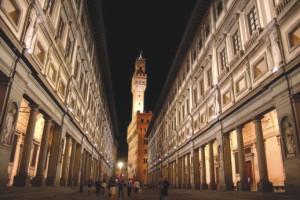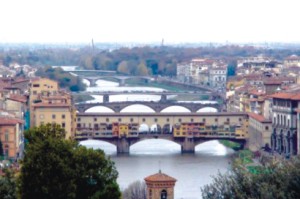| Travel
Harmony in Tuscany
Azizul Jalil
“In Paris you learn wit and in Florence you learn poise.”
Virgil Thomson (American Composer, 1896-1989)
The second part of our Italian tour began with a ride on a super-smooth, super-fast Euro Star train from Rome to Florence (Firenze). Journey by train is very popular in Europe, Italy is no exception. The huge stations with full facilities-waiting rooms with TVs, restaurants and banks etc. were clean and comfortable. Contrary to their past reputation of being easy with time, the Italian trains ran on time. Conveniently located downtown near bus terminals, we took a taxi from the Florence station to our hotel, only about a seven minute ride. City bus stops, small cafes, bakeries and groceries were within walking distance. Florence in the heart of Tuscany, a region of Italy, is known for its rich history, culture, art, architecture and natural beauty. Looking around Tuscany -whether in the cities and towns or in the rolling country side, gives one a feeling of poise and harmony.
After dumping our luggage at the hotel, we lost no time catching a train to Pisa, an hour's journey, where the tower is still leaning. The lime-stone coloured, highly decorated Duomo (church) was located on a vast grassy area, making it very attractive to look at. It had a very large metal door telling a biblical story. The nearby tower, declared a World Heritage Site by UNESCO, had similar ornamental features on its surface. Restoration work was proceeding but that did not diminish the enthusiasm of many people in the long queue to get in and walk hundreds of flights of stairs up to the top. We neither had the time nor the strength to do so.
 |
 |
Uffizi Gallery, Florence. |
The bridges of Florence. |
The presence of a large number of Bangladeshi hawkers selling toys, souvenirs and picture cards to the tourists drew our attention. Some told us that not only retail, Bangladeshi whole sellers were also there in Italy from whom these hawkers procured their supplies. After a decent dinner sitting outdoor in a restaurant with a view of the serene church and the odd-shaped tower, we returned at night to Florence. One half-day for Pisa was quite adequate
Visits to the medieval city of Siena (21 miles south of Florence), once an independent city-state in Tuscany until defeated by Florence and to San Gimignano (32 miles SW of Florence), where wealthy merchants in the middle ages built many (about 72) tall towers to celebrate their wealth and family name were highly recommended. A popular, conducted bus tour was available, which also included Chianti-the area with miles of vineyards on hill slopes, producing fine Chianti wine. Early next morning we joined the tour at the close-by Sita Bus Terminal. The tour took us the whole day. San Gimignano is called the Manhattan of Tuscany because it still preserves 13 of its noble towers, giving it a skyscraper skyline. Its fortress- like appearance is softened by harmonious squares. The approach to the walled town is dramatic. The historic centre of the walled city of Siena has been declared a World Heritage Site by UNESCO. It is a great tourist attraction and is famous for its cuisine, art and medieval cityscape. Because of the stairs and up-hill walks, we could not move around much but saw the narrow streets paved with stone with fancy shops and small houses by the side and the shell-shaped stunning city square- Piazza del Campo surrounded by colourful medieval buildings.
At Chianty, we were shown around a vineyard by Marco, the owner. Thick, heavy clusters of delicious-looking red grapes were hanging from the trellises. He explained the wine-making process and showed us his shining, stainless-steel German-made machinery. We were then entertained with his produce of different quality and taste, with plenty of cheese and bread. Some among us were encouraged to ship back a box or two of the products back home. It was sunset and the panoramic view from the hill-top winery of the grape vines in neat rows on the terraced gold-green hill-slopes all around was an impressive sight. At that moment, Omar Khayyam's oft-quoted poem in Fitzgerald's translation of his Rubaiyat came to my mind:
Here with a Loaf of Bread beneath the Bough, a Flask of Wine, a Book of Verse and Thou
Beside me Singing in the Wilderness-And Wilderness is Paradise now.”
We made good use of the economical whole-day bus tickets to move around Florence during the next two days, though mostly to downtown art galleries, architectural landmarks, piazzas, markets and restaurants. While Rome has its ancient stone monuments of all sorts, highly decorated Florentine buildings of comparatively recent origin have art, culture and sophistication written large on them. There are many bridges spanning the river Arno in the middle of the city, of which the Veechi Bridge is rather unique. A portion of the bridge is enclosed with structures where shops are located. With both high-end and touristic shops-a good portion of the road going over the bridge has a concentration of goldsmiths and jewellers-reminding me of Dhaka's Baitul Mukarram and the Chadni Chawk. There are so many renowned art galleries in Florence that with our limited time and the necessary hours of walking through these required one to be selective. We chose two-the Uffizi and the Pita Palace Galleries downtown, located in huge stone palaces with giant statues in front and decorations on the walls. Hundreds of giant paintings in two floors-mostly with Christian religious themes and vivid life-like portraits of noblemen and women, many by Italy's famous painters like Titian, Michelangelo, Leonardo de Vinci, were displayed there. We had made reservations for the Uffizi and still had to stand in line to get the tickets to get in. We came back with images of glorious colours and excellent paintings lingering in our minds.
One late-afternoon in Florence, we took a 15 -minute bus ride to Piaazale Michelangelo which was on a hill top-perhaps the highest point in town. It had a view of the bridges of Florence, some of which were lighted on both the sides, and a good part of the city and its imposing buildings and churches. A giant statue of the painter of the Sistine Chapel dominated the Piazza. With a mild evening breeze and a mood of love and music prevailing, someone started to play an accordion. This prompted both the younger and the older men and women to begin dancing softly and quietly as if they were in a trance. The setting sun cast a heavenly glow on the entire area and the assembled people. It was a most moving and memorable sight.
Having toured Tuscany, we left Florence for Pesaro on the east coast of Italy, changing trains at Bologna. Because of weather-related delays, we reached Pesaro after about five hours. We had booked a hotel on the Adriatic Sea and were lucky to get a room with a frontal view of the sea. We had specially gone there to see Dr. Arabinda and Sandra Kundu, good friends from my university days in London in the mid-fifties. They spend their summer months in Pesaro since Kundu's retirement from the World Bank in the late-eighties. After an evening walk with them along the pleasant seaside boulevard lined by shops and cafes, we sat down in a cafe overlooking the sea for an enjoyable dinner. Next day, Kundus took us by a private car for a wonderful tour of the hilly country-side to places full of old buildings and churches, and vineyards, olive plants and flowers. It was the end of the summer season-the weather was sunny and mild. We visited Kundus' former summer home and vineyard in nearby Tavulia village where they stayed many years, until they moved to Pesaro two years ago. We stopped in a restaurant for a lunch outdoor-Italian style, right on a cliff with a magnificent view of the sea. Sitting at our table, we could faintly see Venice at a distance to our north and across the sea to the east, Dubrovnik on the Croatian coast. After enjoying their warm hospitality and care for a couple of days, we travelled to Rome in about four hours by a direct Euro Star train, which at places merrily ran parallel to the sea.
Copyright
(R) thedailystar.net 2010 |
|
